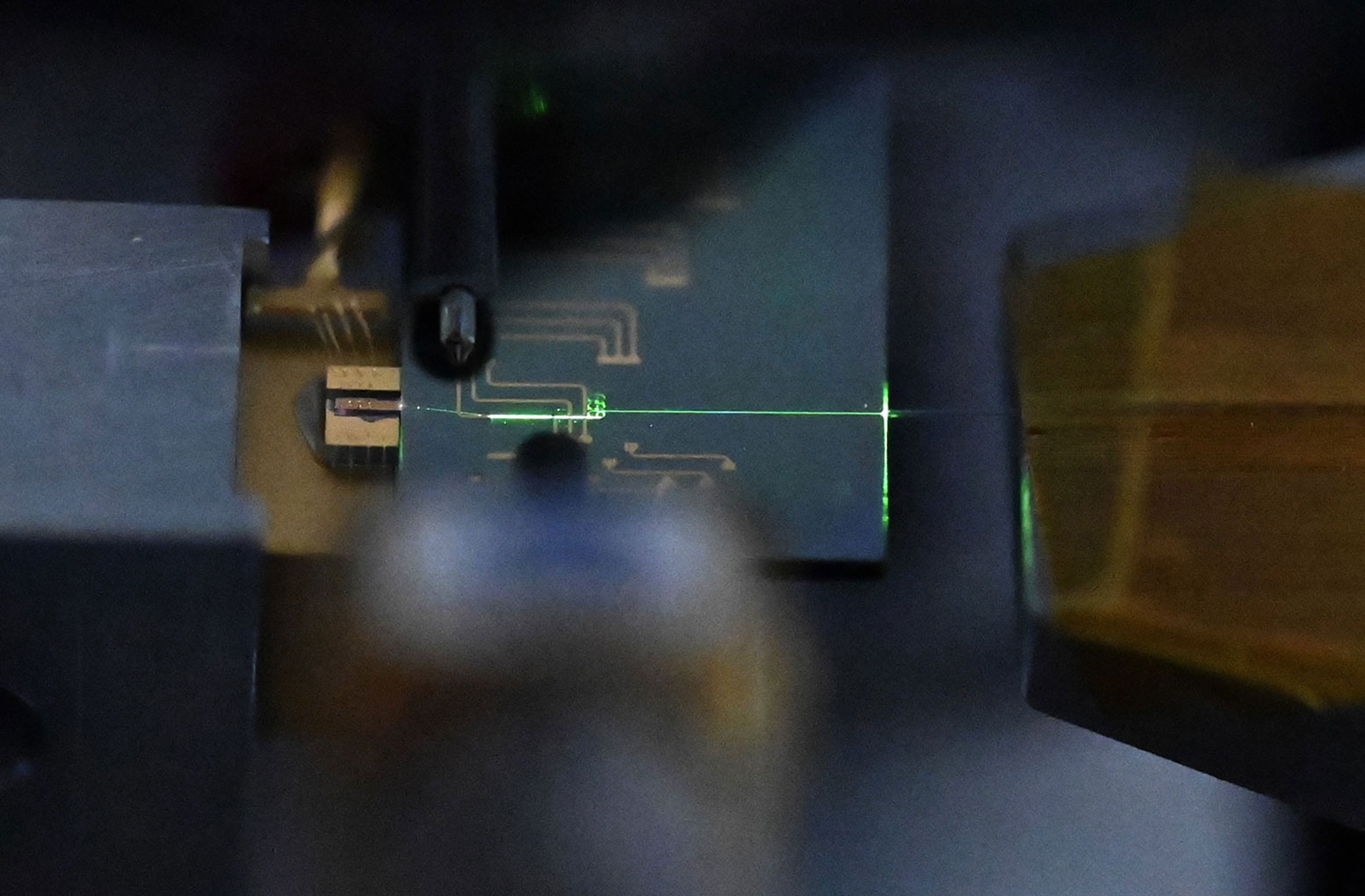Researchers have used lithium niobate in conjunction with gallium-arsenide to build a nanophotonic mode-locked laser, shown here emitting a beam of green light. [Image: Caltech]
Scientists have reportedly made a nanophotonic mode-locked laser that can produce pulses of near-infrared light just 5 picoseconds long with unprecedented energy and peak power. (Science, doi: 10.1126/science.adj5438). They did so by combining a semiconductor optical amplifier with a phase modulator made in a lithium niobate circuit, and believe that they may be able to reduce the pulse length by a further factor of 100.
Fleeting pulses
Mode-locked lasers (MLLs) use either active or passive techniques to correlate the phases of the different longitudinal modes from a broadband gain medium housed within an optical cavity. Once the modes have been locked, interference of the in-phase modes leads to an extremely brief pulse. This pulse partially leaks out of the cavity once a cycle to yield a uniform train of pulses, which in the frequency domain are made up of a series of regularly spaced spikes.
These fleeting pulses—as short as a few femtoseconds (10−15 s)—can be put to a wide range of uses, such as observing the making or breaking of chemical bonds and tracking the movement of electrons within semiconductors or metals. They are also employed in bio-imaging; their high peak power yields nonlinear effects that allows deeper imaging of biological tissue, while their low average power avoids damage to that tissue.
Bulky and expensive
State-of-the-art MLLs rely on fiber-based components and/or free-space crystals, lenses and mirrors, which makes them bulky, power hungry and expensive. Nanophotonic devices, which are far smaller, have lacked the output power and tunability of their table-top counterparts. This is mainly because the III-V semiconductor gain media used in such devices, while yielding large gains over small distances, only allows mode-locking over a narrow range of pumping currents.
In the latest work, Qiushi Guo, Alireza Marandi and colleagues at the California Institute of Technology, USA, show how to overcome this limitation by integrating a gallium-arsenide gain chip with an external mode locker made from a lithium niobate nanophotonic circuit. Just 1 cm long, their electrically pumped actively mode-locked laser forms a Fabry-Perot laser cavity between a reflective facet on the end of the gain chip and a broadband loop mirror on the lithium niobate circuit.
The phase modulator, driven by a sinusoidal radiofrequency signal, works by effectively varying the cavity length at the signal frequency.
The phase modulator, driven by a sinusoidal radiofrequency signal, works by effectively varying the cavity length at the signal frequency. Normally, a pulse inside the cavity would acquire a Doppler frequency shift when reflecting off the oscillating end mirror. But by hitting the mirror just at the point when it reverses direction, the pulse instead has its phase very slightly modulated—allowing it to persist inside the laser cavity in a steady state.
Becoming more efficient
Guo and colleagues put the device through its paces by feeding a 280 mW radiofrequency signal into one end of the mode locker and measuring the laser output. They found that the pulses, with a wavelength of 1065 nm, each lasted around 4.8 picoseconds (10−12 s) and could be generated about 10 billion times per second. The pulses had an energy of at least 2.6 picojoules and a peak power of more than 0.5 W—which is more than twice the value of current nanophotonic integrated MLLs.
What's more, the researchers showed that they could vary the device's repetition frequency and carrier offset frequency over a wide range by adjusting the sinusoidal driving frequency and the pump current to the lasing medium. They also note that y using active feedback to control the pump current, both frequencies can be locked. This capability, they say, would allow the device to operate as a stable frequency comb.
The researchers reckon that integrating other nonlinear functionalities of thin-film lithium niobate with their technology could potentially enable new kinds of integrated photonic systems—such as self-referenced frequency combs, atomic clocks and fully integrated supercontinuum sources.
They add that it should be possible to reduce the laser's pulse length by a further two orders of magnitude by optimizing the mode locker and laser cavity dispersion, as well as exploiting various nonlinear pulse compression techniques available for thin-film lithium niobate nanophotonics.


